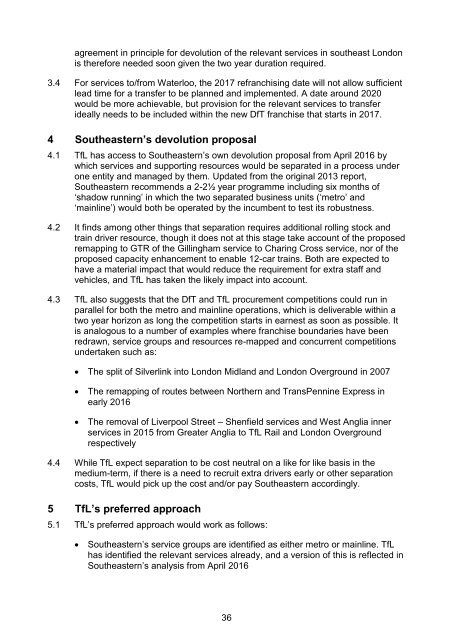Title Rail devolution business case narrative 1 Summary
rail-devolution-business-case-narrative
rail-devolution-business-case-narrative
Create successful ePaper yourself
Turn your PDF publications into a flip-book with our unique Google optimized e-Paper software.
agreement in principle for <strong>devolution</strong> of the relevant services in southeast London<br />
is therefore needed soon given the two year duration required.<br />
3.4 For services to/from Waterloo, the 2017 refranchising date will not allow sufficient<br />
lead time for a transfer to be planned and implemented. A date around 2020<br />
would be more achievable, but provision for the relevant services to transfer<br />
ideally needs to be included within the new DfT franchise that starts in 2017.<br />
4 Southeastern’s <strong>devolution</strong> proposal<br />
4.1 TfL has access to Southeastern’s own <strong>devolution</strong> proposal from April 2016 by<br />
which services and supporting resources would be separated in a process under<br />
one entity and managed by them. Updated from the original 2013 report,<br />
Southeastern recommends a 2-2½ year programme including six months of<br />
‘shadow running’ in which the two separated <strong>business</strong> units (‘metro’ and<br />
‘mainline’) would both be operated by the incumbent to test its robustness.<br />
4.2 It finds among other things that separation requires additional rolling stock and<br />
train driver resource, though it does not at this stage take account of the proposed<br />
remapping to GTR of the Gillingham service to Charing Cross service, nor of the<br />
proposed capacity enhancement to enable 12-car trains. Both are expected to<br />
have a material impact that would reduce the requirement for extra staff and<br />
vehicles, and TfL has taken the likely impact into account.<br />
4.3 TfL also suggests that the DfT and TfL procurement competitions could run in<br />
parallel for both the metro and mainline operations, which is deliverable within a<br />
two year horizon as long the competition starts in earnest as soon as possible. It<br />
is analogous to a number of examples where franchise boundaries have been<br />
redrawn, service groups and resources re-mapped and concurrent competitions<br />
undertaken such as:<br />
The split of Silverlink into London Midland and London Overground in 2007<br />
The remapping of routes between Northern and TransPennine Express in<br />
early 2016<br />
The removal of Liverpool Street – Shenfield services and West Anglia inner<br />
services in 2015 from Greater Anglia to TfL <strong>Rail</strong> and London Overground<br />
respectively<br />
4.4 While TfL expect separation to be cost neutral on a like for like basis in the<br />
medium-term, if there is a need to recruit extra drivers early or other separation<br />
costs, TfL would pick up the cost and/or pay Southeastern accordingly.<br />
5 TfL’s preferred approach<br />
5.1 TfL’s preferred approach would work as follows:<br />
Southeastern’s service groups are identified as either metro or mainline. TfL<br />
has identified the relevant services already, and a version of this is reflected in<br />
Southeastern’s analysis from April 2016<br />
36


